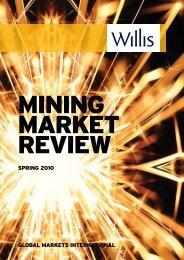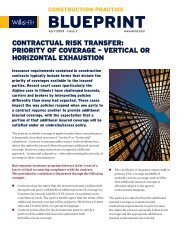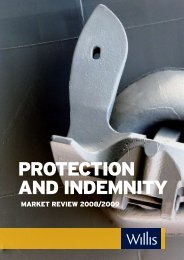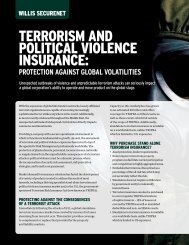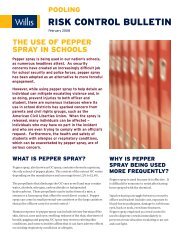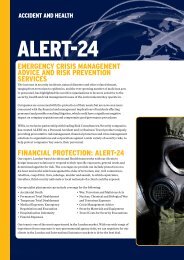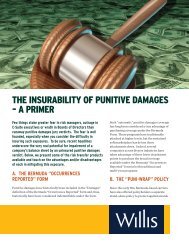spRING 2011 GlobAl MARKETs INTERNATIoNAl - Willis
spRING 2011 GlobAl MARKETs INTERNATIoNAl - Willis
spRING 2011 GlobAl MARKETs INTERNATIoNAl - Willis
Create successful ePaper yourself
Turn your PDF publications into a flip-book with our unique Google optimized e-Paper software.
sustaInaBIlIty<br />
thReats to the MiNiNg iNdustRy<br />
The 2010 Ernst & Young report Business Risks<br />
Facing Mining and Metals identified what they<br />
consider to be the top 10 risks currently facing<br />
the industry. Two of these are particularly<br />
relevant: at no. 4 is ‘Resource Nationalism’, and<br />
no. 5 is ‘Maintaining a social licence to operate’.<br />
Maintaining a social license to operate comes<br />
down to ‘how do you treat your neighbours?’<br />
Increasingly communities and other<br />
stakeholders, both national and local, influence<br />
the permitting process and affect a mine’s<br />
operations, through several factors:<br />
• Media perception and public pressure;<br />
• Political influence, both locally and<br />
nationally;<br />
• Vigilance and whistleblowing to the<br />
regulatory authorities.<br />
Modern communications and the rapid spread<br />
of information (and misinformation) via the<br />
internet means that public perception can<br />
be affected quickly. This can have a great<br />
influence on the mining company itself, on<br />
regulators and licensing authorities, and on<br />
national governments (through the ballot<br />
box). But it also influences lenders and stock<br />
markets, who are increasingly nervous of their<br />
international reputation.<br />
7 | <strong>Willis</strong> | Mining Market Review <strong>2011</strong><br />
Resource nationalisation is also recognised as a growing threat, not<br />
just in developing countries but also in Russia and the CIS where<br />
a constrained inward investment climate is a form of resource<br />
nationalism. ‘Why should we give away our national assets and wealth<br />
to greedy foreigners?’ Inward investment is fine, and without it many<br />
countries’ mineral assets could not be developed. However it is often<br />
perceived that not enough of the benefits of such project investment<br />
are retained in the country, or are used for the benefit of the region<br />
or community. It can be perceived that too much of the value goes to<br />
outsiders and to a few company executives and maybe government<br />
officials, whilst local communities and national economies do not<br />
receive a sufficient share of this bounty.<br />
In response to threats such as these, the Mining industry has begun<br />
to respond by embracing the principles of sustainable development<br />
and transparency.<br />
What does tRaNsPaReNCy MeaN?<br />
In a business context, transparency means two things:<br />
• Operating in a fair, open and sustainable way, to the benefit of all<br />
stakeholders in a project.<br />
• A fair distribution of benefits and rewards, in relation to the risks<br />
and impacts.<br />
Is this just green propaganda and are such ideals possible in a free<br />
market system? Many believe that the answer is yes, but only if the free<br />
market is regulated and responsible, and a company is responsible to<br />
all its stakeholders.




